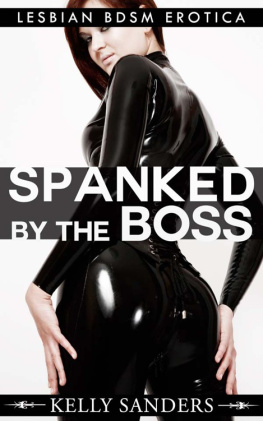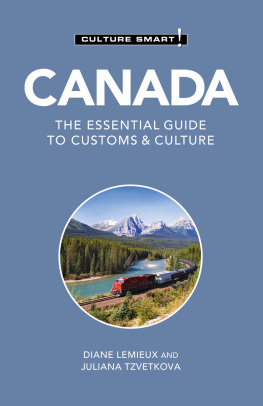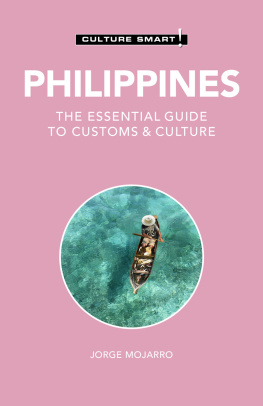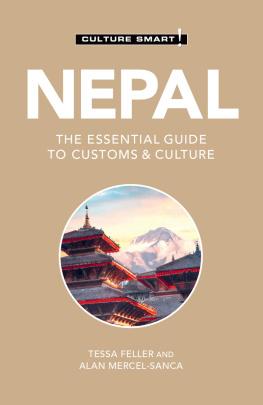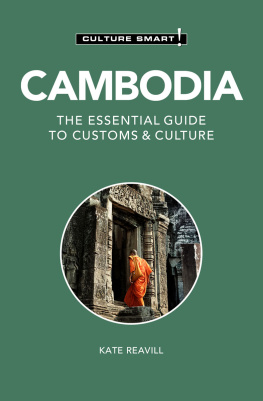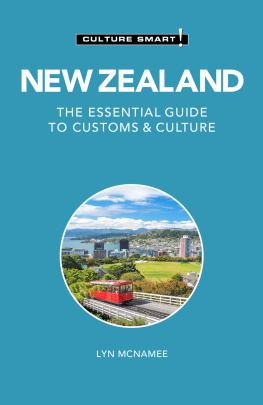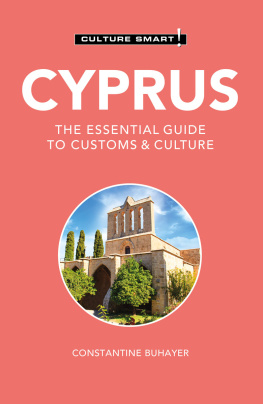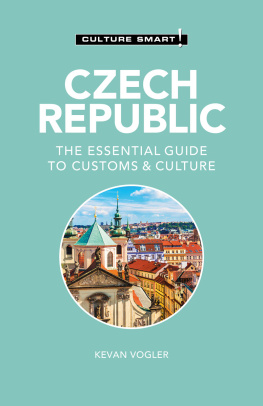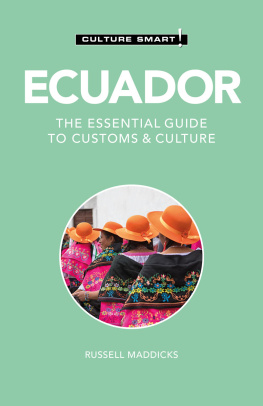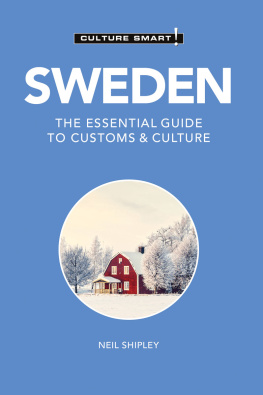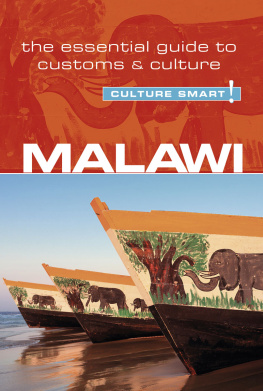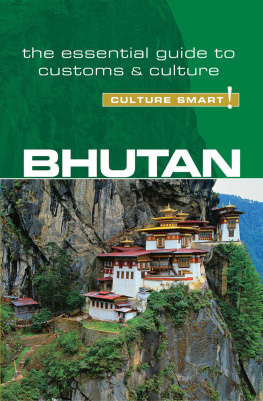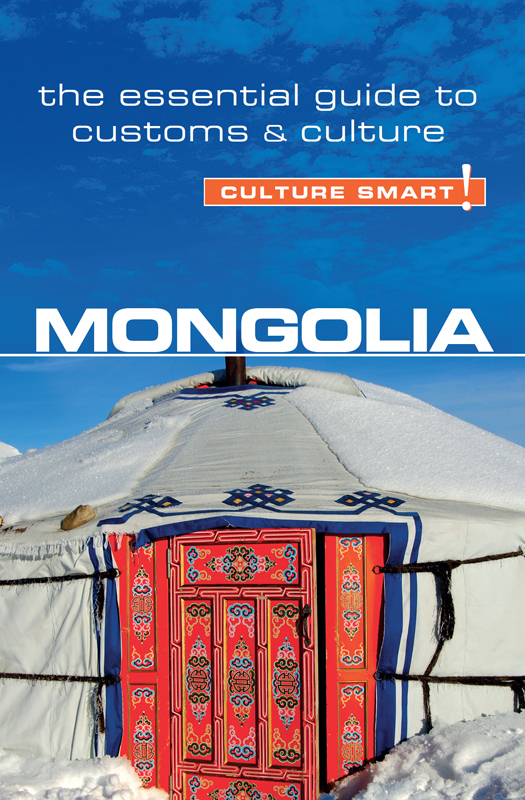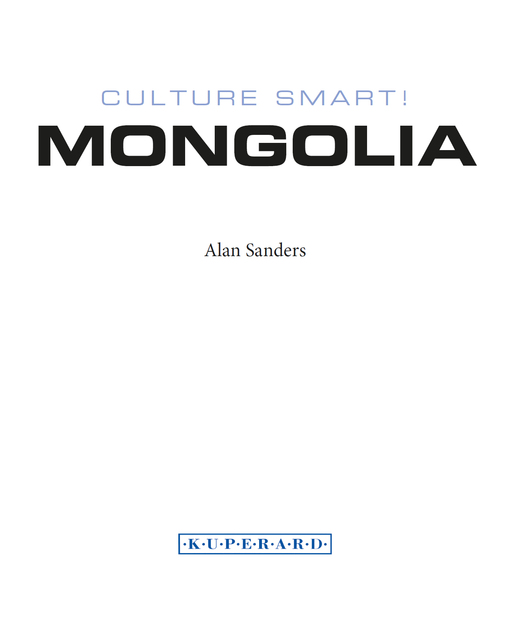ISBN 978 1 85733 717 4
This book is also available as an e-book: eISBN 978 1 85733 718 1
British Library Cataloguing in Publication Data
A CIP catalogue entry for this book is available from the British Library
First published in Great Britain
by Kuperard, an imprint of Bravo Ltd
59 Hutton Grove, London N12 8DS
Tel: +44 (0) 20 8446 2440 Fax: +44 (0) 20 8446 2441
www.culturesmart.co.uk
Inquiries:
Series Editor Geoffrey Chesler
Design Bobby Birchall
Cover image: Traditional Mongolian ger, felt-covered round tent, in winter. Alamy
Images on the following pages reproduced under Creative Commons Attribution-Share Alike 4.0 International license: Anand.orkhon.
Reproduced under Creative Commons Attribution-Share Alike 3.0 Unported license: Shoyuramen.
Under Creative Commons Attribution-Share Alike 2.5 Generic license: Eric Pouhier.
Under Creative Commons Attribution-Share Alike 2.0 Generic license: mikeemesser.
GNU Free Documentation License, Version 1.2: Konstantin Nikiforov.
president.mn
eBook ISBN: 978-1-85733-718-1
v3.1
About the Author
ALAN SANDERS is the leading British authority on Mongolia. Formerly the lecturer in Mongolian Studies at Londons School of Oriental and African Studies, now, after many years at BBC Monitoring, he is a freelance consultant writing about Mongolias political and economic scene.
He has written extensively for the weekly Far Eastern Economic Review, co-authored the Lonely Planet Mongolian Phrasebook, and wrote Routledges Colloquial Mongolian. His Historical Dictionary of Mongolia (Scarecrow Press) has gone to three editions, he has updated the Mongolia chapters in the annual Far East and Australasia (Europa/Routledge), and revised the online Mongolia for Encyclopaedia Britannica.
Alan is a member of the International Association of Mongolian Studies, Ulan Bator, and of the Mongolia Society at Indiana University, and contributes to publications of the Mongolia and Inner Asia Studies Unit, University of Cambridge. He was awarded the Mongolian Order of the Pole Star for promoting BritishMongolian relations.
The Culture Smart! series is continuing to expand.
For further information and latest titles visit
www.culturesmart.co.uk
The publishers would like to thank CultureSmart!Consulting for its help in researching and developing the concept for this series.
CultureSmart!Consulting creates tailor-made seminars and consultancy programs to meet a wide range of corporate, public-sector, and individual needs. Whether delivering courses on multicultural team building in the USA, preparing Chinese engineers for a posting in Europe, training call-center staff in India, or raising the awareness of police forces to the needs of diverse ethnic communities, it provides essential, practical, and powerful skills worldwide to an increasingly international workforce.
For details, visit www.culturesmartconsulting.com
CultureSmart!Consulting and CultureSmart! guides have both contributed to and featured regularly in the weekly travel program Fast Track on BBC World TV.
contents
Map of Mongolia
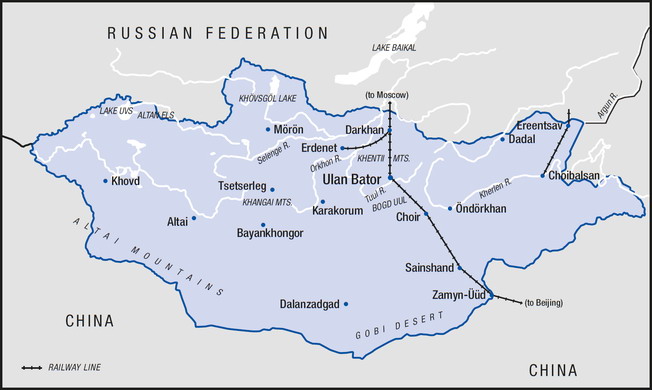
introduction
Mongolia is landlocked between China and Russia in the heart of Asia. For centuries after the disintegration of Genghis Khans empire it was ruled by one neighbor or the other, but in the 1990s the Mongols abandoned Soviet socialism and turned to democracy. Proud of their heroic past, they are rebuilding their national heritage. During seventy years of Kremlin control, they had gained schools, hospitals, factories, and housing, but lost their freedom, history, religion, and written language. Today they try to preserve a balance with their eternal neighbors, who inevitably maintain considerable influence, while embracing their third neighborthe United States, Europe, and Japan. In the transition to a market economy Mongolia is a land of pioneers. Its greatest asset is the Mongol people, who are friendly, well educated, and ambitious. The first foreign language, once Russian, is now English. Its business leaders are striving to develop their resource-rich but infrastructure-poor country through international partnerships. The freely elected parliament has formed a series of coalition governments, aiming through consensus and sustainable growth to end poverty and inequality.
Travelers from across the world are drawn to the land of blue sky by its picturesque mountains and lakes, flower-carpeted steppes and stony deserts, home to snow leopards, wild horses and camels, and Gobi bears. The broad pasturelands, with herds of grazing livestock and the traditional nomadic lifestyle, contrast remarkably with the busy streets of the capital. Ulan Bator is a bustling city of over a million people, modern buildings and shops, interspersed with Buddhist monasteries and temples and surrounded by crowded suburbs of traditional felt tents. Culture Smart! Mongolia provides vital insights and useful tips from an experts understanding of the people and the country, rarely in the news but making steady progress toward democracy and modernity.
Spelling and Names
There is no agreed system for transliterating the Mongolian Cyrillic alphabet into English spelling. In this book most of the letters used to reproduce Mongolian words may be pronounced as in English. The rest are generally ch as in church, e = den, g = golf, j = jewel, kh = loch, o = hot, = yearn, ts = cats, u = awful, = put, z = adze. Vowels with an initial glide, or y-sound, are ya = yard, ye = yearn, yo = yodel, yu = you, y = yurt. Double vowels are long and stressed: aa, ee, oo, , uu, . The letter v is between v and w, except that govi is Anglicized as gobi.
The name of the capital, Ulan Bator, often written Ulaanbaatar on the basis of the Cyrillic spelling, is pronounced Oolahnbarter, with stress on the second and third syllables. Although the traditional English spelling is Genghis Khan, the Mongolian pronunciation Chingis is closer (stress on the first syllable). The variant Chinggis Khaan is derived from the classical uigarjin script. Gengis (hard g) is to be avoided. Khan is a rank, not a surname.
Key Facts
| Country Name | Mongolia | Mongolian Peoples Republic, 192492 |
| Capital | Ulan Bator (Ulaanbaatar) | Pop. 1.3 million |
| Main Towns | Erdenet, Darkhan | Pop.100,000; 75,000 |
| Population | 3.0 million (est. 2014). 66.9% urban, 33.1% rural | Density 1.9 persons per sq. km; average family 3.7 persons |
| Area | 603,909 sq. miles (1,564,116 sq. km) |






